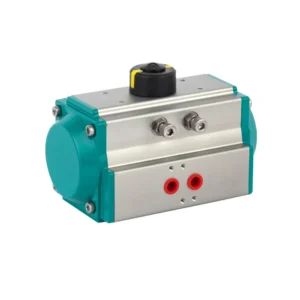Pneumatic actuator
Showing the single result
-
Pneumatic actuator
BT SERIES
A rack and pinion pneumatic actuator is a type of rotary actuator used to automate the opening and closing of quarter-turn valves such as ball valves and butterfly valves. By converting compressed air energy into rotational motion, these actuators provide reliable, fast, and cost-effective valve operation in a wide range of industrial applications.
Rack and pinion pneumatic actuators are an essential part of modern valve automation systems. With a simple but effective design, they provide reliable torque output, easy automation, and compatibility with various control accessories. Whether in industrial automation, fluid control, or safety systems, these actuators ensure efficient and dependable performance.
The actuator uses a rack and pinion mechanism to convert linear motion into rotary torque:
1. Compressed air is applied to the pistons inside the actuator.
2. As the pistons move linearly, they engage a rack gear.
3. The rack turns the pinion gear, which is connected to the actuator shaft.
4. This motion rotates the valve stem, opening or closing the valve.
________________________________________
🔁 Types of Rack and Pinion Actuators
1. Double Acting
• Air is required for both opening and closing.
• Offers full torque in both directions.
• Suitable for applications needing fast, reliable cycles.
2. Spring Return (Single Acting)
• Air opens the actuator, and a spring closes it (or vice versa).
• Ideal for fail-safe applications where the valve must return to a default position during power loss.
________________________________________
🧩 Main Components of a Rack and Pinion Actuator
• Body: Typically made from anodized aluminum, stainless steel, or coated steel.
• Pistons: Provide linear force to drive the rack.
• Rack & Pinion: Gear system for converting linear motion to rotary torque.
• End Caps: House the springs (in spring return models).
• O-rings/Seals: Prevent air leakage and contamination.
• Drive Shaft: Connects to the valve stem.
• NAMUR Interfaces: For mounting accessories like solenoid valves and positioners.
________________________________________
🏭 Applications of Rack and Pinion Pneumatic Actuators
These actuators are widely used for automated valve control in:
• ✅ Oil & Gas pipelines
• ✅ Water treatment plants
• ✅ Food & beverage processing
• ✅ Chemical & pharmaceutical industries
• ✅ Power generation
• ✅ HVAC and utility systems
• ✅ OEM machinery and skid packages
________________________________________
📊 Key Specifications to Consider
Parameter Description
Torque Output Measured in Nm; depends on air pressure
Air Supply Pressure Typically 2.5–8 bar (35–120 psi)
Rotation Angle 90° standard; optional 120°, 180°
Mounting Standard ISO 5211 for valve mounting
Control Interface NAMUR VDI/VDE 3845 for accessories
Material Aluminum, stainless steel, or coated body
________________________________________
✅ Benefits of Rack and Pinion Actuators
• Compact and lightweight design
• Cost-effective for many applications
• Easy integration with solenoid valves, limit switch boxes, and positioners
• High cycle life and minimal maintenance
• Available in ATEX or explosion-proof versions
• Suitable for on/off and modulating control
________________________________________
🛠️ Maintenance & Installation Tips
• Ensure correct air pressure and clean supply via filters.
• Check for leaks in fittings and seals.
• Lubricate if specified by the manufacturer.
• Match actuator torque to valve breakaway torque.
• Use ISO 5211 adapters for mounting on different valves.
• Follow safety procedures during installation and service.

